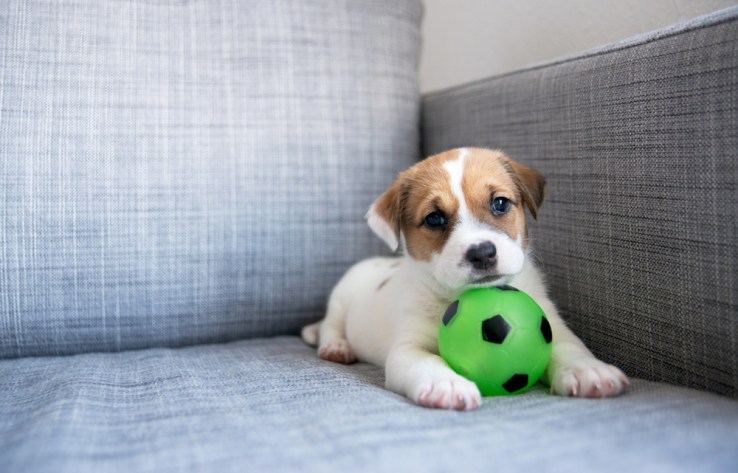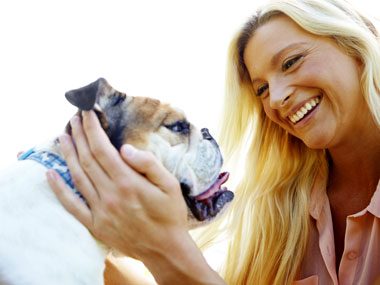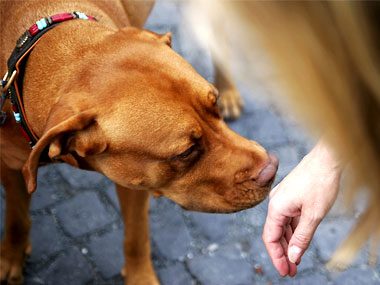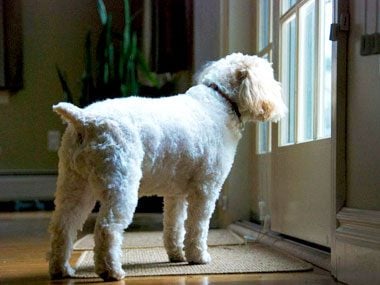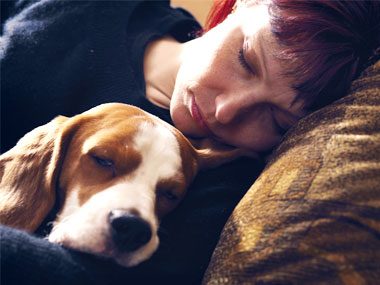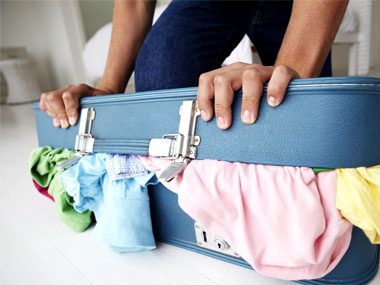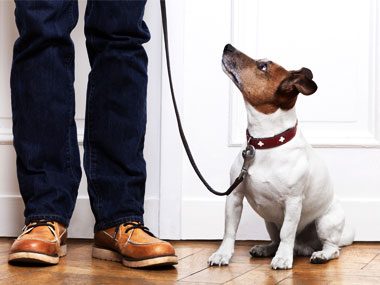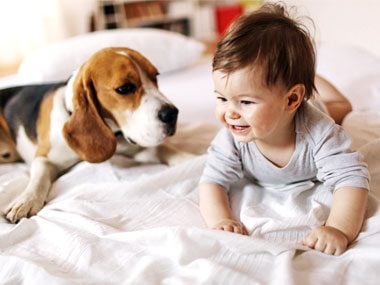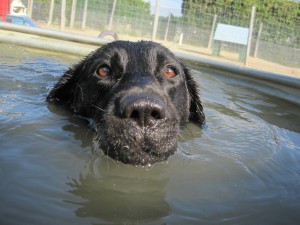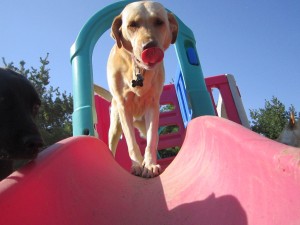The term “doggie daycare” has become a panacea in recent years for all manner of canine behavioral ills. Does your dog engage in destructive chewing? Nuisance barking? Rude greetings? Poor canine social skills? Mouthing and biting? Separation anxiety? Just send him to doggie daycare, and all will be well. You hope.
[PDFCAP(1)]
I’ll admit I’m as guilty as the next trainer of suggesting a daycare solution for a huge percentage of my behavior consult clients. The fact is, many of today’s canine companions suffer from a significant lack of exercise, stimulation, and social time with their own kind. A good daycare provider can go a long way toward meeting those needs. But daycare is not the one-size-fits-all answer that we would like it to be; there are many factors to take into consideration before enrolling your dog in your friendly neighborhood doggie hangout.
Who shouldn’t go to daycare
Not all dogs are appropriate daycare candidates. Just because they are a social species doesn’t mean all dogs get along with each other. Humans are a social species and we certainly don’t all get along! It’s important that you honestly evaluate your dog’s personality and behavior to determine if he has the potential to do well at daycare. If he plays well with others, is comfortable and confident in public, and doesn’t mind being separated from you, then daycare may be a fine choice. If any of those are questionable, proceed with care.
If your dog doesn’t enjoy interacting with other dogs, he’ll likely find daycare a very unpleasant experience, and his dislike of dogs will probably get worse.
When the planets are aligned just so – with a well-managed, highly trained staff and a perfect set of playmates – some dogs who are mildly fearful of other dogs may develop greater social skills and ease around their own kind. But many a dog-fearful dog has become reactive-aggressive as a result of being forced into proximity with other canines. Total immersion in dogdom is not an appropriate behavior modification or management plan for a dog who is intimidated by his own kind. Many dogs simply become less dog-playful as they mature, and a day at doggie daycare is not the fun party for them we imagine it is. Of course, geriatric dogs and those with medical conditions should not be asked to endure the rough-and-tumble play of dogs at a daycare center.
 |
| Play groups should be comprised of dogs who are compatible in size, age, and play style, and all the dogs should appear to enjoy themselves. |
Undersocialized dogs who are environmentally fearful and/or afraid of humans also do not belong at puppy playschool. While a dog who was rescued from a puppy mill or a hoarder may feel more comfortable in the presence of a pack of dogs because that’s what he knows, he can be difficult, perhaps even dangerous, for staff to handle. If something should happen – he escapes, or is injured and in need of treatment – the situation goes from bad to worse. The escapee will be impossible to catch, and is likely to head out in a beeline for parts unknown. A fearful dog who must be cornered and restrained by strangers for treatment in an already high-stress environment is very likely to bite, perhaps with alarming ferocity as he struggles to protect himself from what he may perceive as his impending death.
A canine bully or any dog who is otherwise offensively aggressive toward other dogs is also not an appropriate daycare attendee. Don’t think sending him to daycare will teach him how to play well with others. It’s more likely to do the exact opposite! He’ll find it quite reinforcing to have the opportunity to practice his inappropriate bullying or aggressive behavior – and behaviors that are reinforced invariably increase and strengthen.
 |
| Dogs who get picked on - or who seem to be in fear of being picked on - need to be moved to a group with fewer, smaller, and/or gentler play companions. |
Finally, dogs who suffer from separation anxiety are often horrible candidates for daycare. (For more about separation anxiety, see “Scared to Be Home Alone,” WDJ July 2008.) Owners of dogs with separation anxiety often hope their dogs will relax in the company of other dogs and humans, and trainers often suggest daycare as a solution for the dog who is vocal or destructive when left alone. But if your dog is at the extreme end of the separation-distress/anxiety continuum, sending him to daycare doesn’t make him any happier, and only makes those who have to spend the day with him (canine and human) stressed as well. True separation anxiety – in which the dog has a panic attack if separated from the one human he has super-bonded to – is not eased by the presence of other dogs or humans. Less severe manifestations of isolation/separation distress may be alleviated by a daycare provider. Be honest with your prospective provider about your dog’s separation-related behavior, and see if she’s willing to give it a try. Be ready to celebrate if it works, and look for another solution if it doesn’t.
Perfect candidates
In contrast, if your dog loves to play with others, doesn’t have significant medical problems that would preclude active play, and has energy to spare, he’s the ideal candidate for doggie daycare. This professional service, offered by a high-quality provider, is the perfect answer to many a dog owner’s prayers.
Perhaps you have a friendly, active young dog, and you just don’t have the time you would like to devote to his exercise and social exposure. You come home exhausted from a grueling day at work and he greets you with a huge grin on his face, his wagging tail clearly begging for a hike in the woods or an extended session of ball-retrieve. If you don’t exercise him you risk the emergence of inappropriate behaviors such as chewing, but you are just too tired, and you have to work on a project, due tomorrow. Daycare, even one or two times a week, can be the perfect outlet for his boundless energy, give him the social and dog-play time he covets, and relieve you of the oppressive guilt of not being able to take him for that hike.
 |
| All prospective daycare attendees should be screened for their ability to get along with other dogs in every type of circumstance. |
You may not know whether your dog is an appropriate daycare candidate until you show up for your interview and the staff assesses your dog. Note: if the facility you’re considering accepts your dog without an assessment, look for another provider. Even if your dog passes the assessment, daycare staff may advise you after a visit or two that your dog is stressed and not enjoying his play experience there. If that’s the case, you remove him from daycare, and/or inquire about possible behavior modification programs to help him have more fun at dog play.
Be choosy
One of the pitfalls of suggesting daycare to clients is the dearth of high-quality providers in most areas. If you are considering sending your canine pal off to a professional dog-sitting facility for the day, you want to be confident that he’ll be as safe and happy in their hands as he is in yours. You should see each prospective provider’s facility (preferably when dogs are present), and talk to its manager and staff.
You may need to make an appointment in order to get the best tour of a daycare facility. There are times (especially in the morning during peak drop-off hours and in the afternoon during peak pick-up hours) when it will be extremely difficult to spare a staff member to show you around. Call ahead and ask when it would be best to see the facility.
As you visit facilities and interview managers and staff, observe the dogs that are present in the daycare centers. They should appear happy, not stressed. Staff should also appear happy, not stressed, and be interacting with the dogs. The environment should be calm and controlled, not chaotic, and your take-away impression should be one of professional competence as well as genuine caring for dogs. Trust your instincts. If anything doesn’t seem right, don’t leave your dog there. If staff says you cannot observe the dogs, we suggest walking away. (See “No Viewing ‘For the Dogs’ Safety?’ ” next page.)
One of the most important things to ask about is the dog to staff ratio. This can range from 10 dogs or fewer per staff person to as many as 20 or more dogs per caretaker. “Obviously, the fewer dogs per person, the more closely supervised your dog is likely to be, and the less likely any canines are to get into trouble,” says Robin Bennett, co-owner of All About Dogs Daycare in Woodbridge, Virginia.
Cost is also an important factor, but don’t select your provider by cost alone; neither the lowest-priced nor the highest-priced facility may be suitable for your dog. Depending on where you live and the specifics of the facility, cost per day can range from a few dollars to $40 or more per day. Facility specifics vary. “The daycare may be operated out of a private home or a multi-staffed, full-service facility,” says Bennett. “Multi-staffed facilities are naturally costlier, but can offer a much wider range of services to meet the needs of individual dogs.”
 |
| Not even a rainy day can dampen the enthusiasm of most active young dogs for outdoor, social exercise! It helps when the daycare staff is also willing to go out and play in the weather - and towel the dogs off when they come back inside. |
Speaking of services: In a full-service facility, trained staff members keep the dogs busy with indoor or outdoor play, or even, in some cases, happily munching snacks and watching movies made just for the entertainment of dogs. Activities might include hide and seek, tag, or anything that canine minds can come up with. Many facilities provide a variety of toys and balls to enjoy, and some even have swimming pools! Some also offer training, from good manners to agility and more. Good daycare centers also include rest time so dogs don’t get over-stimulated by having too much fun.
Other things to ask about include:
What is the assessment process? If they don’t assess, run away fast. If they do, be sure you’re comfortable with the things they tell you they will be doing with your dog, before you let them do it.
What vaccinations do they require? Make sure you’re comfortable with the requirements. Don’t compromise your dog’s physical health by over-vaccinating or administering unnecessary shots just to satisfy daycare. If they ask for vaccinations you’d prefer not to give your dog, see if they’ll accept a letter from your veterinarian stating that in her opinion your dog is adequately protected.
How do they determine appropriate play groups? Your Maltese should not be in a play group with a Great Dane, or vice versa. Nor should a body-slamming adult Labrador be playing with a space-sensitive Border Collie puppy. If you get the proper answer (play style, size, and age) make sure your observations of the groups playing support their answer.
“To minimize risk of injury, dogs should be separated based on play style, size, and age,” says Bennett. “Keep in mind that accidents and injuries can happen in all facilities. Dog daycare is like a child’s playground, and by allowing dogs to play together there is a risk of injury. Collars can present a hazard during dog play, but dogs without collars have no visible identification. Discuss this conundrum with your potential provider to see how they handle it, and be sure you are comfortable that escape risks are minimal at the facility. You should see multiple doors within the facility to the playrooms and secure high fences around outdoor play yards.”
Do they feed the dogs treats? If so, are the treats a type and quality that is compatible with your dog’s diet – especially if he has allergies or you are committed to high quality foods? Can you provide your own treats to give him, and if you do, can they ensure he gets your treat and not the others? If you ask them to refrain from feeding treats, or limit the amount, will they?
What kind of dog handling and behavior training does the staff receive? What training books and authors do they recommend? What tools do they use? Staff members should be reading books by the growing list of positive, science-based author-trainers. If dominance-based television celebrities are held in high regard, run away fast.
How frequent are serious incidents, requiring staff intervention, of inappropriate behavior between dogs? These should be rare. If they happen more than a few times a year, the facility has a serious problem.
How do they deal with incidents involving inappropriate behavior between dogs? Incidents should be defused by separating dogs calmly, only using physical tools such as water, loud noises, blankets, and boards if absolutely necessary. Squirt bottles and noise aversives should not be routine management tools. Verbal and physical punishments, including shock collars, are totally and completely unacceptable. There should be planned debriefings after an incident occurs to determine what went wrong and prevent a recurrence. Solutions include putting dogs in different play groups, or asking offenders not to return unless and until adequate behavior modification has been implemented.
What if a dog is injured? Do they have a regular consulting veterinarian who is available during all daycare business hours? If not, is there an emergency clinic available? Will they transport to your veterinarian if that’s your preference? Who pays the vet bill?
The provider should notify you immediately if your dog is seriously injured, either by another dog or some other physical mishap, and honor your preference for veterinary care if at all possible. There are reasonable arguments on both sides of the “who pays” question, but you should be aware in advance of their policies so you’re not surprised.
Has a dog ever escaped? If so, how did it happen, and what have they done to prevent future escapes?
Has any staff ever been bitten by a dog? If so, what were the circumstances? Was the bite reported to authorities? (In many jurisdictions, all dog bites are technically required to be reported, but often are not unless they are serious enough to require medical attention.) If your dog bites and is reported, he will likely have to be quarantined for a period of time (often 10 days) and the incident may trigger “dangerous dog” legal proceedings. Bites can happen. But if the facility you’re considering has a history of lots of dog bites, there’s a serious problem.
